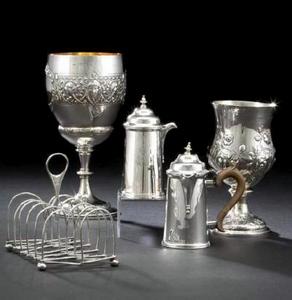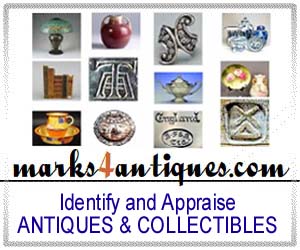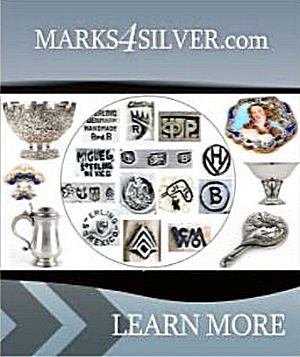Identification and Price guides for Antiques & Collectibles


ANTIQUE GEORGIAN SILVER:
Identification & Appraisal Values
Join the most updated and complete collectibles research online - Learn more...
 GEORGIAN SILVER refers to Silver Hollowware & Silverware made mostly in England in the early 18th to early 19thC during the reign of George I (1714 - 1727), George II (1727 - 1760), George III (1760 - 1820) and George IV (1820 - 1830). Because the entire span of the Georgian Period lasted for over a century, during which there were different decorative styles adopted by Silversmiths & Jewelers of the time, the term "Georgian" is now used mostly as a general age reference and is not very precise in describing a particular style. In fact, a more accurate distinction refers to shorter parts of this time period, namely EARLY GEORGIAN (1710 - 1720s), MIDDLE GEORGIAN (1720s - 1770s) and LATE GEORGIAN (1770s - 1830).
GEORGIAN SILVER refers to Silver Hollowware & Silverware made mostly in England in the early 18th to early 19thC during the reign of George I (1714 - 1727), George II (1727 - 1760), George III (1760 - 1820) and George IV (1820 - 1830). Because the entire span of the Georgian Period lasted for over a century, during which there were different decorative styles adopted by Silversmiths & Jewelers of the time, the term "Georgian" is now used mostly as a general age reference and is not very precise in describing a particular style. In fact, a more accurate distinction refers to shorter parts of this time period, namely EARLY GEORGIAN (1710 - 1720s), MIDDLE GEORGIAN (1720s - 1770s) and LATE GEORGIAN (1770s - 1830).
The best way to confirm if a particular silver antique could be referred to as Georgian is to look up its maker's marks & hallmarks. For example, using the information provided in our Silver & Jewelry Marks Guides, you can pinpoint the exact time-frame that an item was made and then determine whether "Georgian Silver" is the appropriate designation. As mentioned, "Georgian" primarily refers to English Silver of the period, but some collectors have erroneously expanded the use of this term to apply to silverware made in other countries around the same time.
During the Georgian period, silver hollowware & silverware came in many decorative forms, most prominent of which are the ROCOCO STYLE, NEO-CLASSICAL STYLE, ADAM STYLE, REGENCY STYLE, and GOTHIC REVIVAL STYLE. Most antique silver pieces are characterized by specific design elements that place them in each style category but may incorporate a mix that renders them slightly harder to tell. In this particular case, all of the aforementioned styles tend to employ elaborate details when it comes to antique silver, with special artisan and silversmithing techniques that enhance their overall look and it is often nearly impossible to distinguish them with any degree of certainty.
In addition to the usual silver tableware, such as teapots or kettles, silver serving dishes or platters & trays, and silver tureens or similar hollowware that were mainly of utilitarian nature, collectible Georgian Silver includes Candlesticks & Candelabra, Silver Utensils, Goblets (some as Glass or Crystal Overlay), Silver Cruets, and of course Silverware & Cutlery. Yet, the majority of these are elegantly decorated and are nowadays very collectible, often because of their sheer beauty and sterling silver content rather than their usefulness.
Because Georgian Silver is synonymous with a period prior to the invention of any serious industrial silver-plating methods (e.g. Electroplating, a.k.a. "EPNS"), the largest percentage of Georgian Silver found today in the secondary antiques market are in Sterling Silver. They should all be appropriately marked according to the Assay or Standards Hallmarks as regulated by the UK government of the time. Sheffield Plating was the only practical way to plate silver during the Georgian era, which nevertheless was still fairly laborious and costly, but still less expensive than Fine or Sterling Silver. For more on silver and how it was made, please see some of our articles here.
English Georgian Silver also became the main inspiration for design forms and styles for American silversmiths when this profession was still in its infancy on this side of the pond. Although most American silver of the time and before mid-19thC was Coin Silver, their output was second to none in terms of quality and these pieces are even more desirable by collectors as they were especially rare, such as items made by PAUL REVERE in Boston, MA. Almost all American silver antiques from that period used pseudomarks that were in imitation of authentic British Hallmarks in order to gain market acceptance. Since this was not illegal as there were no official Silver Hallmarking Standards in the US, these marks can be challenging in deciphering and one needs to use caution because some of these same marks were also used on ordinary silverplated ware.
Prices of antique Georgian Silver have escalated dramatically during the past decade, mostly because of their Sterling Silver content, which has appreciated significantly since the financial and banking crisis. Like all other precious metals, antique sterling silver seems to have increased in value at an unprecedented rate and is considered to be a good and solid investment. When this inherent worth as a precious metal is coupled with its strong aesthetic appeal, Georgian Silver antiques are easily considered very desirable collectibles. Georgian silverplated antiques are also very popular with collectors, in this case mostly because of their beautiful designs and careful workmanship since the vast majority were made by hand, one at a time. This is especially true if their maker is clearly marked on each piece and is also well-known and documented.
Unlock the true value of your collection with our comprehensive research guides from identifying makers' marks to appraising all kinds of antiques and collectibles, including items featured in this article.
Our up-to-date information will give you an accurate understanding of your items' worth. Don't miss out on this valuable resource - visit our research tools today!
In addition to some examples shown below on this page, you can also search our price guide for your own treasures.
Examples of related items from our Price Guides
-
GEORGIAN SILVER GILT VINAIGRETTE, ETC.Georgian [more like this]
-
TWO GEORGIAN SILVER SERVING SPOONS The first, [more like this]
-
A GROUPING OF VICTORIAN AND GEORGIAN SILVER [more like this]
-
GEORGIAN SILVER CONDIMENT GROUP, CA. 1801Georgian [more like this]
-
Georgian Silver Parcel Gilt Pocket Watch [more like this]
-
Group of Georgian Silver, late 18th/early [more like this]
-
GEORGIAN SILVER FLATWARE, ETC.Georgian silver [more like this]
-
GEORGIAN SILVER TEAPOT AND CREAMERGeorgian [more like this]
-
SET OF SIX GEORGIAN SILVER TABLESPOONSSet [more like this]
-
ENGLISH GEORGIAN SILVER TEA SERVICE, 19TH [more like this]
-
JEWELRY. ANTIQUE DIAMOND INLAID BIRD PENDANT. [more like this]
-
GROUP OF ENGLISH SILVER AND SILVER PLATE [more like this]
There are many more auction results available to our members...
Explore more items from our
Antiques & Collectibles Price Guide
A COLLECTION OF ENGLISH STERLING AND[more like this]
GROUP OF ENGLISH SILVER AND SILVER PLATE[more like this]
GROUP OF SEVEN SILVER AND SILVER PLATE-MOUNTED[more like this]
A Group of Five Silver and Silver-Plate[more like this]
A Group of English Silver and Silver-Plate[more like this]
(LOT OF 28) SILVER AND SILVER PLATE[more like this]
A Pair of English Three-Light Silver-Plate[more like this]
A Group of English and American Silver-Plate[more like this]
A Group of American and English Silver[more like this]
Pair of English sterling silver & Sheffield[more like this]
Pair of English neoclassical style silver-plated[more like this]
Set of English Silver and Silver Plate[more like this]
This list is limited to only a few results.
Many more items are available to our members through our
Price Guides!






